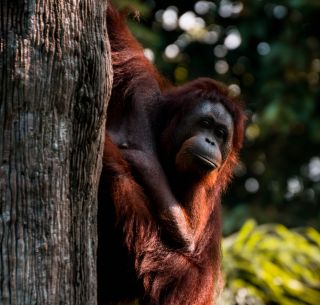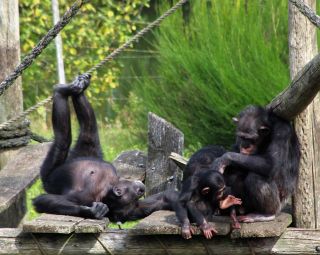Laughter
The Search for Laughter’s Evolutionary Origins
To fully grasp laughter’s form and function, we must first uncover its genesis.
Posted May 30, 2023 Reviewed by Vanessa Lancaster
Key points
- We can’t fully understand laughter’s meaning and purpose without knowing its evolutionary origins.
- Comparative behavioral studies suggest laughter-like vocalizations are found in all modern great apes.
- If functionally equivalent to human laughter, it suggests a developmental period of 14-18 million years ago.

In earlier posts, the Mutual Vulnerability Theory of Laughter has allowed us to make substantial progress in addressing three of the four most basic questions scientists ask about any behavior (Martin, 1984; Chiszar, 1981).
First, it revealed laughter’s function as the primary means of communicating a sense of mutual vulnerability. Second, it sheds light on its development over the course of an individual’s lifetime, from infancy through adulthood. And third, it listed some of the factors that affect the way laughter is elicited in the individual, its so-called proximate causation. This post begins our look at the last question: What is laughter’s ultimate causation, its evolutionary origins? Why should we laugh at all, and why express feelings of amusement as a vocalization instead of, say, wiggling our ears or crossing our eyes?
For some, the idea that behaviors have an evolutionary history at all, let alone one we can theorize about, seems foreign. When discussions of evolution arise, they almost always concern physical attributes—body shape, the number of toes or teeth, or the thickness of a shell. These tend to be preserved in ancient fossil beds or the anatomy of present-day life forms. But it’s important to remember the physical characteristics of a species result from its members attempting to behave in a certain manner. They must do certain things, such as avoid predators, gather water and energy, and disperse into other favorable environments.
Just like physical traits, innate behaviors are the end products of genetic and epigenetic factors, with certain variants selected for based on their ability to increase survival and reproduction (Weitz, 1979). Behavioral tendencies, therefore, evolve in the same manner as physical traits. And, as with physical features, new behavioral variants don’t arise out of a vacuum. Selection, both genetic and cultural, works best through the modification of existing traits. So, to fully understand why laughter takes the form it does, we must identify the behavior from which it evolved (Smith, 1977; Tanner, 1981; Mithen, 1996; Chiszar, 1981).
Determining the age of laughter
Ethology is the branch of biology that concerns itself most with investigating behavior, including communicative behavior. Ethology is built upon the premise that, under normal conditions, organisms will most often act in ways that function to maximize the probability of their long-term reproductive success (Smith, 1977).
Instinctive behaviors, then, should also undergo change through the same process of natural selection and can be traced back to earlier forms using similar methods of comparative analysis. For many structural elements, clues about their age and origins can sometimes be found directly in the form of fossilized bones or body impressions. Behaviors such as communication are more difficult to assess. Biomechanics might be able to reveal the physical capacity to make a certain range of sounds, but we can only speculate about an organism’s motivation to do so. For this reason, we must begin our search among the living and then work our way back into the past.

Our first step was initiated in a prior post. That laughter is exhibited by every healthy member of our species suggests it’s not a learned behavior, but rather inborn. A principle of evolutionary biology, termed “phylogenetic comparison,” holds that if a given trait is shared by all the constituents of a genetically related group, there is a high probability it was derived from (that is to say, present in) their founding population–their last common ancestors–for it’s much more likely that such a characteristic was inherited than the result of independent development in each of its members (Wrangham, 1987; Miles, 1994; Smith, 1977). If one accepts the genetic and fossil evidence suggesting that all modern humans are descended from a common ancestral population living in Africa some 150,000 to 250,000 years ago, we can say with some confidence that laughter is at least that old.
To look further back in time, we must broaden the scope of our comparison. We will need to look at humanity’s family tree.
Humankind’s closest living relatives
The current consensus of the scientific community is that our closest living nonhuman relatives are the “great apes”–the common chimpanzee, pygmy chimpanzee (more frequently referred to as the bonobo), and gorilla, all native to tropical Africa, and the orangutan, which inhabits Borneo and Sumatra.1 The less-than-two-percent genetic difference between humans and African apes suggests that we have some 99.9999997 percent of our entire evolutionary history in common (Tattersall, 1998). It would only make sense that we would also share much in the way of behavior, especially in the realm of nonverbal communication. Miles and Harper (1994) explained the rationale:
It’s clear that contemporary apes are not identical to fossil hominoids from which they evolved because all of the great apes have some derived characteristics. In addition to biological changes, living apes may have developed their protoculture through selection pressures from changes in behavior, such as tool-using and more complex social organization....
However, since all four of the great apes (orangutan, gorilla, large [common] chimpanzee, and pygmy chimpanzee) show similar intelligence and susceptibility to enculturation, it is most likely that ape cognitive and communicative similarities are due to their common ancestry. We note that there has been a consistency in ape econiches and brain size over time. This suggests that although ape communicative behavior and cognitive abilities may have undergone some evolution, Miocene hominoid forms had communicative and cognitive abilities similar to the most basic ones exhibited by living apes in natural settings. It follows then, that the roots of ape skills, as well as those of human language, are found in the preadaptations of the common hominoid ancestor, from which both the pongids and hominoids evolved.

Observations of great apes, both in the wild and in captivity, leave no doubt that all use some form of laughter-like vocalization in social interactions, suggesting that a common ancestor, living some 14 – 18 million years ago, did as well.
This post was drawn from Chapter Seven of Why We Laugh: A New Understanding.
© John Charles Simon
References
1. Note: The family Pongidae consists of the common chimpanzee (Pan troglodytes), pygmy chimpanzee or bonobo (pronounced boNObo; Pan paniscus), gorilla (Gorilla gorilla), and orangutan (Pongo pygmaeus). Humans (Homo sapiens), of course, are also members of the great ape family. However, in this and future posts, rather than refer to the others as “nonhuman great apes,” I’ll simply denote our species as “humans” and the rest as “great apes.”
Chiszar, D. (1981). Learning Theory, Ethological Theory, and Developmental Plasticity. In E. S. Gollin (Ed.), Developmental Plasticity: Behavioral and Biological Aspects of Variations in Development. New York: Academic Press.
de Waal, F. B. M. (1997). Bonobo: The Forgotten Ape. University of California Press.
Martin, P. (1984). The (Four) Whys and Wherefores of Play in Cats: A Review of Functional, Evolutionary, Developmental and Causal Issues. In P. K. Smith (Ed.), Play in Animals and Humans. New York: Basil Blackwell.
Miles, H. L. W. and S. E. Harper. (1994). “Ape Language” Studies and the Study of Human Language Origins. In D. Quiatt and J. Itani (Eds.), Hominid Culture in Primate Perspective. University Press of Colorado.
Mithen, S. J. (1996). The Prehistory of the Mind: A Search for the Origins of Art, Religion and Science. London: Thames and Hudson.
Simon, J. C. (2008). Why We Laugh: A New Understanding. Starbrook Publishing.
Smith, J. W. (1977). The Behavior of Communicating: An Ethological Approach. Cambridge, Massachusetts. Harvard Univ. Press.
Tanner, N. M. (1981). On Becoming Human. Cambridge: Cambridge Univ. Press.
Tattersall, I. (1998). Becoming Human: Evolution and Human Uniqueness. Orlando, FL: Harcourt Brace and Co.
Weitz, S. (1979). Facial expression and visual interaction. In S. Weitz (Ed.), Nonverbal Communication, 2nd Edition. New York: Oxford Univ. Press.
Wrangham, R. W. (1987). The significance of African apes for reconstructing human social evolution. In W. G. Kinzey (Ed.), The Evolution of Human Behavior: Primate Models. State University of New York Press, Albany.




